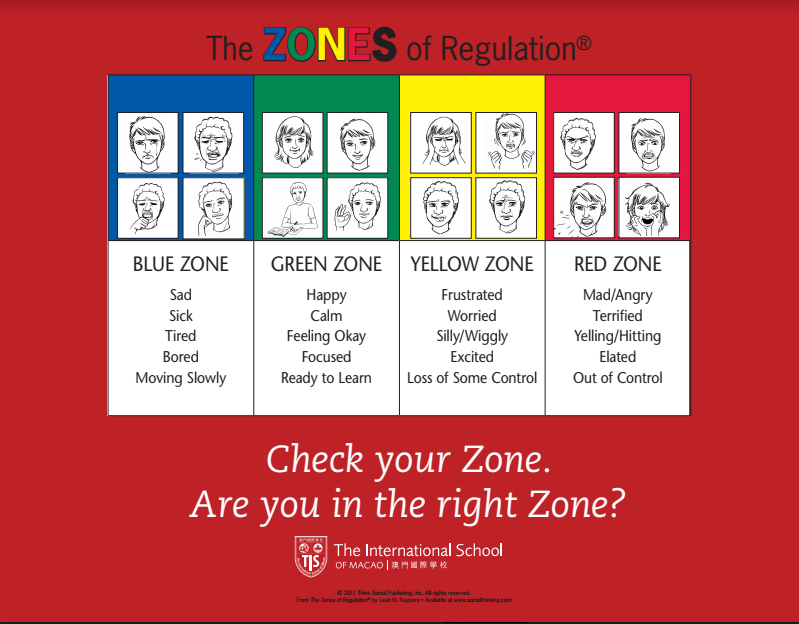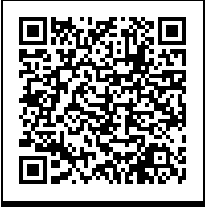At TIS, the Elementary school has implemented the Zones of Regulation program as part of the social and emotional curriculum. We will now offer this training for parents so that you too can follow up with these strategies at home. Training will be conducted by Rovanna Bawden, Student Services Head.

What is the ZONES Model?
Children can be taught GOOD coping and regulation strategies so that they can help themselves when they become stressed, anxious, or sad or overexcited. Self-regulation is the ability to recognize and adjust levels of alertness, focus, emotions and moods and to regulate responses in order to achieve goals.
Typically, kids who can self-regulate will turn into teens who can self-regulate. Self-regulation skills are vital for the success and happiness of our children.
WHAT ARE THE ZONES? There are four zones to describe how your brain and body feel.
BLUE Zone – Your body is running slow, such as when you are tired, sick, sad or bored.
GREEN Zone – Like a green light, you are “good to go.” You body may feel happy, calm and focused.
YELLOW Zone – This zone describes when you start to loose control, such as when you are frustrated, anxious, worried, silly or surprised. Use caution when you are in this zone.
RED Zone – This zone is for extreme emotions such as anger, terror and aggression and excitement. When you are in this zone, you are out of control, have trouble making good decisions and must STOP!
What is Zone Training for Parents?
Parent and Carer Training using The Zones of Regulation can be utilized as a home model for behavioural regulation. As with any program that teaches specific vocabulary it is very important that parents and carers are made aware of how the Zones work so that they too can follow up with the strategies used in the home environment. For this purpose we are pleased to offer these sessions to you.
What is included in this program?
Tools for parents to use that develop strategies for: Self-control, Resiliency, Self-management, Anger management, Impulse control, Sensory regulation.
Requirements: Two sessions are required to complete the initial training. You will receive certification for the parent training after completion.
Group sessions: 35 participants maximum.
Registration through this link:

Translation will be provided for the sessions.
Venue: Student Services Floor 3 SW
Division 1
| Session | Date | Time | Grade | Description |
| Session 1 of 2 | Tuesday Jan 30 | 1:45-3pm | 1-3 | Introduction to the Zones for younger children |
| Session 2 of 2 | Tuesday Feb 6 | 1:45-3pm | 1-3 | Tools to Use at Home. Effective strategies that really work with younger children so they are able to be more self aware, more descriptive in their explanation of feelings and therefore more able to control rising emotions |
Division 2
| Session | Date | Time | Grade | Description |
| Session 1of 2 | Wed Jan 31 | 1:45-3pm | 4-6 | Introduction to the Zones for older children |
| Session 2 of 2 | Wed Feb 7 | 1:45-3pm | 4-6 | Tools to Use at Home. Effective strategies that really work with older children so they are able to be more self aware, more descriptive in their explanation of feelings and therefore more able to control rising emotions |
為小學家長提供如何在家為孩子進行情緒管理的培訓
澳門國際學校為小學階段開展情緒管理計劃作為社交及情感課程的一部份。本校期望透過家長培訓,讓家長在家跟進有關策略。學生服務部主任Rovanna Bawden 將帶領該培訓。
情緒管理是甚麼?
孩子可透過學習良好的應對及管理策略,幫助面對壓力、焦慮、悲傷或過度興奮的影響。自律是一種能力,可以幫助孩子識別以及調節其警覺性、專注力、情感、情緒以及反應來獲取成功。
通常學會自律的孩子長大後能成為自律性高的青少年。自律性對於孩子的成功和快樂至關重要。
甚麼是情感區域?把大腦和身體的感覺以四個顏色區域來劃分描述。
藍區:身體反應緩慢,如感到疲倦、不適和苦悶時。
綠區:就像開了綠燈一樣,感覺良好。身心狀況快樂、平和以及專注。
黃區:此區域代表你開始失控,如感到沮喪、焦慮,擔心、愚蠢和驚訝。當在此區域時要當心。
紅區:此區域代表著極端情緒,如憤怒、恐懼、有攻擊性或極端興奮。若情感處於此區域,人會容易失控,不能作出好的決定,必須靜止!
家長情緒管理培訓是甚麼?
家長和監護人可以在家利用情緒管理的策略來調整孩子的行為,如同孩子學習新詞彙一樣,家長和監護人會清楚了解到這些區域如何運作並在家裡根據策略來應對狀況。
培訓內容內包含甚麼?
家長將學習到情緒管理的不同策略,包括自制力、復原力、自我管理、憤怒管理、衝動控制以及感觀調理。
要求:初階培訓分兩階段(共兩節,2.5小時)進行。完成後可獲發培訓證書。
小組培訓:每班35人
報名:請用以下連結報名

翻譯:中文
地點:南翼三樓學生服務部
初小
| 節數 | 日期 | 時間 | 年級 | 內容 |
| 第一節 | 一月三十日,週二 | 下午1時45分至3 時 | 1-3 | 介紹年幼孩子的情緒區域 |
| 第二節 | 二月六日,週二 | 下午1時45分至3 時 | 1-3 | 在家策略。有效的策略能更好地培育年幼孩子的自我意識,更好地描述自身感受,從而更能控制情緒的上升 |
高小
| 節數 | 日期 | 時間 | 年級 | 內容 |
| 第一節 | 一月三十一日,週三 | 下午1時45分至3 時 | 4-6 | 介紹年幼孩子的情緒區域 |
| 第二節 | 二月七日,週三 | 下午1時45分至3 時 | 4-6 | 在家策略。有效的策略能更好地培育年齡較大的孩子其自我意識,更好地描述自身感受,從而更能控制情緒的上升 |